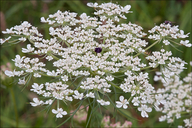|
|
click photo for larger file

Daucus carota ssp. carota
Wild Carrot
|
Photographer: Dr. Amadej Trnkoczy
ID: 0000 0000 0717 0500 (2017-07-04)Copyright © 2017 Dr. Amadej Trnkoczy
|
|
INFORMATION PROVIDED WITH THE PHOTO
|
date of photo Jul 24, 2007
latitude 46.33025 longitude 13.55928
View on Google Maps.
location
Bovec basin, near dirt road leading to former garbage depot, East Julian Alps (Posočje, Slovenia)notes Slo.: navadno divje korenje - Habitat: grassland, moved once per year, flat terrain; calcareous, alluvial ground; full sun; elevation 460 m (1.500 feet); average precipitations ~ 3.000 mm/year, average temperature 8-10 deg C, alpine phytogeographical region. Substratum: soil. Comment: Daucus carota ssp. carota is a very common and widespread grassland plant belonging to parsley family (Umbelliferae, Apiaceae). It blooms from June to October. All cultivated forms of kitchen carrot have only been derived from this species. Contrary to kitchen carrot it has white, thin root, which is also edible when young. But soon it becomes too woody. Although Apiaceae members are numerous and frequently quite difficult to be determined to species level (frequently seeds are needed for this purpose), Daucus carota ssp. carota is a clear exception. In spite of its tripinnate, finely divided leaves, which are common to so many species in this family and the fact that it too is quite variable, it possesses some traits, which enable really easy determination. The most remarkable is a single, small dark purple, almost black, sterile flower in the centre of each (mostly) white umbel (Fig.7). It is in a so sharp contrast to other flowers of large white (compound) umbels of the plant that it seems like an 'error'. And indeed, it is hard to comprehend what evolution or its manager 'had in mind' when creating it. Also the long and tender, thin, lower bracts, which are characteristically three-forked or pinnate, distinguish the plant from all other white-flowered umbellifers (Fig. 6). The shape of young umbels as well as when they form seeds is very characteristic (Fig.3 and 8). Umbels are not rounded but flat, frequently also slightly concave. When you will once find and determine the plant you will remember it forever solely on its habitus. Ref.: (1) E.J. Jäger, Rothmaler 3, Exkursionsflora von Deutschland, 11. Aufl., Elsevier, Spectrum (2007), p 377. (2) A. Martinči et all., Mala Flora Slovenije (Flora of Slovenia - Key) (in Slovenian), Tehnična Založba Slovenije (2007), p 412. (3) M.A. Fischer, W. Adler, K. Oswald, Exkursionsflora für Österreich, Liechtenstein und Südtirol, LO Landesmuseen, Linz, Austria (2005), p 828. (4) D. Aeschimann, K. Lauber, D.M. Moser, J.P. Theurillat, Flora Alpina, Vol. 1., Haupt (2004), p 1152.camera Nikon D70 /Nikkor Micro 105mm/f2.8
contributor's ID # Bot_213/2007_DSC1526 photo category: Plant - annual/perennial
|
MORE INFORMATION ABOUT THIS PLANT
|
| common names
Wild Carrot, Bird's Nest, Bishop's Lace, Queen Anne's Lace (photographer)
View all photos in CalPhotos of Daucus carota ssp. carota Check Google Images for Daucus carota ssp. carota |
|
The photographer's identification Daucus carota ssp. carota has not been reviewed. Click here to review or comment on the identification. |
|
Using this photo The thumbnail photo (128x192 pixels) on this page may be freely used for personal or academic purposes without prior permission under the Fair Use provisions of US copyright law as long as the photo is clearly credited with © 2017 Dr. Amadej Trnkoczy.
For other uses, or if you have questions, contact Dr. Amadej Trnkoczy amadej.trnkoczy[AT]siol.net. (Replace the [AT] with the @ symbol before sending an email.) |
|
|
